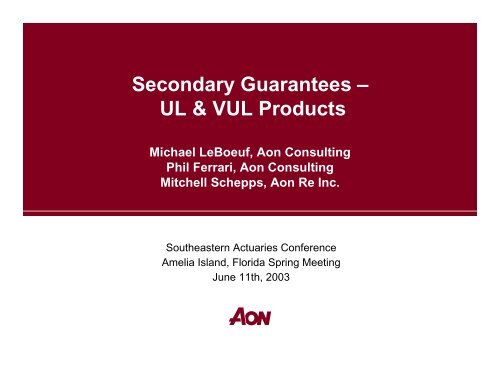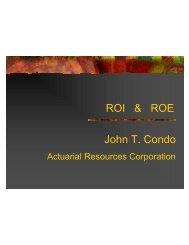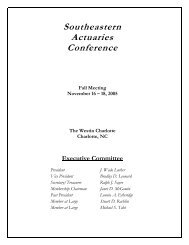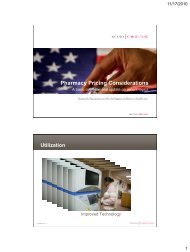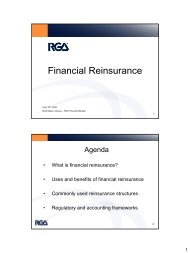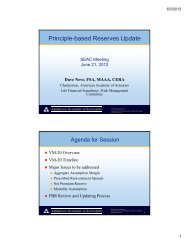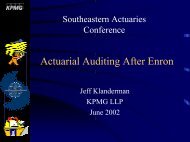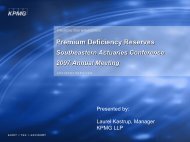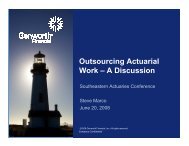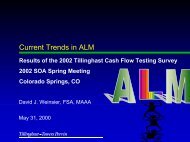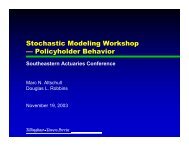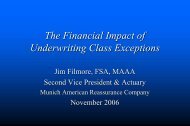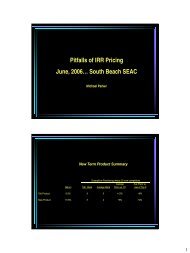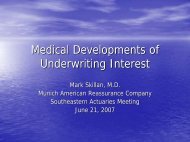Secondary Guarantees â UL & VUL Products - Actuary.com
Secondary Guarantees â UL & VUL Products - Actuary.com
Secondary Guarantees â UL & VUL Products - Actuary.com
You also want an ePaper? Increase the reach of your titles
YUMPU automatically turns print PDFs into web optimized ePapers that Google loves.
<strong>Secondary</strong> <strong>Guarantees</strong> –<br />
<strong>UL</strong> & V<strong>UL</strong> <strong>Products</strong><br />
Michael LeBoeuf, Aon Consulting<br />
Phil Ferrari, Aon Consulting<br />
Mitchell Schepps, Aon Re Inc.<br />
Southeastern Actuaries Conference<br />
Amelia Island, Florida Spring Meeting<br />
June 11th, 2003
Presentation Overview<br />
• For Universal Life and Variable Life <strong>Products</strong><br />
– Description of <strong>Secondary</strong> Guarantee Provisions<br />
– Valuation Changes and Their Impact on <strong>Secondary</strong><br />
Guarantee Designs<br />
– Methods Used to Manage the Financial Impact of XXX<br />
and AXXX<br />
– Impact of the 2001 CSO Mortality Table<br />
• Reinsurance Market Overview<br />
– <strong>UL</strong> <strong>Secondary</strong> <strong>Guarantees</strong><br />
– Current Environment<br />
1
Universal Life<br />
Overview<br />
2
Description of <strong>Secondary</strong> Guarantee Provisions<br />
• Stipulated Level Premium<br />
– Most <strong>com</strong>mon<br />
– Provides a guarantee of X years so long as a specified<br />
level annual premium of Y is paid.<br />
– Typically has little funding flexibility<br />
• May provide an interest discount for pre-payment of<br />
premium.<br />
• May provide a catch-up provision.<br />
3
Description of <strong>Secondary</strong> Guarantee Provisions<br />
• Shadow Accounts<br />
– Policy will not lapse so long as a secondary policy<br />
account has positive value.<br />
• Not clear-cut to the consumer.<br />
– COI guarantees < 1980 CSO and an interest rate > policy<br />
guarantees.<br />
– Total flexibility in structuring a secondary guarantee<br />
period on a policy.<br />
• Better pre-payment value by discounting pre-payments<br />
4
Description of <strong>Secondary</strong> Guarantee Provisions<br />
• Annually Renewable Term<br />
– A cross between Stipulated Level Premium and Shadow<br />
Account Designs.<br />
• A defined premium structure like the level premium<br />
approach.<br />
• Interest discounting provides funding flexibility of Shadow<br />
Account designs.<br />
– Provides many advantages of a Shadow Account design<br />
and can be administered on a system that can handle a<br />
Stipulated Level Premium design.<br />
5
Valuation Changes<br />
Impact on <strong>Secondary</strong> Guarantee Designs<br />
• History<br />
– Initially no additional reserving requirements<br />
• Some Companies used a Gross Premium Valuation w/<br />
PADS.<br />
– Valuation of Life Insurance Policies Model Regulation<br />
#830 (Guideline XXX)<br />
• Addresses the perceived inadequate reserve levels on<br />
secondary guarantee <strong>UL</strong> contracts.<br />
– Actuarial Guideline AXXX<br />
• Addresses how to appropriately value certain secondary<br />
guarantee designs under Guideline XXX.<br />
6
Valuation Pre-XXX<br />
• Offered long-term secondary guarantees and held the<br />
<strong>UL</strong>-CRVM reserve<br />
– <strong>UL</strong> Model Regulation did not address long-term<br />
guarantees.<br />
• Some <strong>com</strong>panies did recognize that the <strong>UL</strong>-CRVM<br />
reserve may not be sufficient.<br />
– Gross Premium Valuations used to be<strong>com</strong>e more<br />
<strong>com</strong>fortable that the <strong>UL</strong>-CRVM level was sufficient.<br />
7
Valuation – The Impact of XXX<br />
• Expected that secondary guarantee designs would now<br />
have reserve levels similar to traditional life contracts.<br />
– The new method for determining deficiency reserves<br />
resulted in large initial surplus strains<br />
– Depending on X-factors for the <strong>com</strong>pany<br />
• Of course, the impact of XXX was not the same for all<br />
secondary guarantee designs…<br />
8
Valuation – The Impact of XXX<br />
• XXX does not apply to Shadow Account designs?<br />
– Policy forms did not have a specified premium(s).<br />
– That view ultimately went away.<br />
• Today most view Shadow Account designs as a series<br />
of 1-year minimum premium guarantees for XXX.<br />
– The series of guarantees structured to be a single segment<br />
as defined under XXX (Section 4B).<br />
9
Valuation – The Impact of XXX<br />
• The resulting XXX reserve level for Shadow Accounts<br />
was at the ½ c x<br />
level using the unitary method.<br />
• The same XXX result occurs on ART designs.<br />
– This fueled their rise in popularity.<br />
10
Valuation – The Impact of AXXX<br />
• Actuarial Guideline AXXX addressed two issues.<br />
– Adjusting XXX reserves a “catch-up” provision.<br />
• Retroactive to the earlier of a state’s adoption of XXX or<br />
the NAIC Accounting Practices and Procedures Manual.<br />
– Adjusting XXX reserves when the secondary guarantee<br />
is being pre-funded.<br />
• Applies to contracts issued on or after the later of the date<br />
of a state’s adoption of XXX and 1/1/2003.<br />
11
Valuation – The Impact of AXXX<br />
• Adjusting XXX reserves for a catch-up provision<br />
– Basic and Deficiency reserves are <strong>com</strong>puted as if the<br />
secondary guarantee premium requirements are met.<br />
• Basic reserve is reduced by:<br />
Catch<br />
−Up<br />
×<br />
Basic<br />
Basic Re serve<br />
+ Deficiency Re<br />
serve<br />
– Basic reserve may not be less than zero.<br />
12
Valuation – The Impact of AXXX<br />
• Deficiency Reserve is reduced by<br />
Catch<br />
−Up<br />
×<br />
Deficiency Re serve<br />
Basic + Deficiency Re serve<br />
– Deficiency reserve may not be less than zero.<br />
• Adjustment for a catch-up provision effectively only<br />
impacts a Stipulated Level Premium design.<br />
13
Valuation – The Impact of AXXX<br />
• Adjusting XXX reserves for pre-funding the secondary<br />
guarantee premiums.<br />
– To establish appropriate reserve levels for Shadow<br />
Account and ART designs.<br />
– Impacts Stipulated Level Premium designs, but not as<br />
dramatically.<br />
14
Valuation – The Impact of AXXX<br />
Steps for adjusting XXX reserves for pre-funding<br />
1. Establish minimum gross premiums at issue that<br />
satisfy the secondary guarantee requirement.<br />
• For Shadow Accounts = the series of 1 year minimum<br />
premiums.<br />
2. Determine basic and deficiency reserves by applying<br />
7B and 7C of the XXX Model Regulation.<br />
• For Shadow Account and ART designs, unitary reserves<br />
(½ c x ) are developed<br />
15
Valuation – The Impact of AXXX<br />
3. Determine amount of actual premiums paid in excess<br />
of minimum gross premiums from step 1.<br />
• For Shadow Account designs = the value of the shadow<br />
account.<br />
• For ART and Stipulated Level Premium contracts =<br />
cumulative premiums paid in excess of minimum<br />
secondary guarantee requirements.<br />
• Adjusted with interest credited at the rate specified under<br />
the secondary guarantee.<br />
16
Valuation – The Impact of AXXX<br />
4. Determine the single premium payment necessary at<br />
the valuation date to fully fund the secondary<br />
guarantee.<br />
• Assume no previous pre-funding. I.e. For a Shadow<br />
Account design the value of the shadow account is zero<br />
• Divide the result in Step 3 by the result in Step 4.<br />
17
Valuation – The Impact of AXXX<br />
5. Compute a net single premium on the valuation date<br />
for the coverage provided by the secondary guarantee<br />
for the remainder of the secondary guarantee period.<br />
• Use any value table and select factors authorized in<br />
Section 5A of the XXX Model Regulation.<br />
• This allows the use of the 10-year select factors<br />
incorporated into the 1980 amendments to the SVL or the<br />
19-year select mortality factors in the XXX Model<br />
Regulation.<br />
• X-factors may not be used.<br />
18
Valuation – The Impact of AXXX<br />
6. Determine the “net amount of additional premiums”<br />
by multiplying by multiplying ratio developed in Step<br />
4 by the difference in the NSP from Step 5 and the<br />
XXX basic & deficiency reserves calculated in Step<br />
2.<br />
Step<br />
6 = Step 4 × ( Step 5 − Step<br />
2)<br />
– This is the maximum amount of additional reserve<br />
impact from AXXX.<br />
19
Valuation – The Impact of AXXX<br />
7. Calculate a “reduced deficiency reserve” by<br />
multiplying the deficiency reserve by 1 - the ratio<br />
from Step 4.<br />
• Cannot be less than zero.<br />
• By pre-funding, part of the deficiency reserve can be<br />
turned into basic reserve.<br />
• A potential benefit from a tax reporting perspective.<br />
20
Valuation – The Impact of AXXX<br />
8. Total Reserve is the lesser of the NSP from Step 5<br />
and the amount of Step 6 plus the total basic and<br />
deficiency reserves<br />
• This amount should be reduced by policy surrender<br />
charges.<br />
• Note the guideline indicates surrender charges are the<br />
account value less the cash surrender value.<br />
• If this amount is less than the basic and deficiency<br />
reserves from Step 2, then the Step 2 reserves are to be<br />
used and no further calculation is required.<br />
21
Valuation – The Impact of AXXX<br />
9. Determination of increased basic reserve<br />
• The increased basic reserve is equal to the total reserve<br />
from Step 8 less the reduced deficiency reserve from<br />
Step 7.<br />
• Easy to see impact and formula usage through a<br />
simple example at one duration…<br />
22
Impact of Regulation AXXX<br />
Current AV 45.24 Step 2 2.46<br />
Current CSV 22.39 Step 3 38.88<br />
Surrender Charge 22.85 Step 4 145.92<br />
<strong>UL</strong> CRVM Res 33.82 Ratio 27%<br />
Step 5 341.94<br />
Step 6 90.44<br />
Step 7 0.00<br />
Step 8 70.05<br />
Step 9 70.05<br />
• Policy Reserves increased from 33.82 to 70.05 due to the impact<br />
of AXXX.<br />
23
Methods Used to Manage the Financial Impact<br />
of XXX and AXXX<br />
• Product Design<br />
– Significant effort today to minimize the impact of AXXX<br />
on Shadow Account and ART designs.<br />
– Focused on introducing features limiting early duration<br />
build-up of pre-payment values.<br />
24
Methods Used to Manage the Financial Impact<br />
of XXX and AXXX<br />
• Surplus Relief<br />
– Executed within the corporation or using an outside<br />
reinsurance facility.<br />
– While saving the <strong>com</strong>pany’s own capital, the cost for<br />
the surplus relief has not sufficiently improved product<br />
returns to the <strong>com</strong>pany.<br />
25
Methods Used to Manage the Financial Impact<br />
of XXX and AXXX<br />
• Reinsurance<br />
– Reinsurance <strong>com</strong>panies willing to reinsure both the<br />
mortality and no-lapse risk on the contract.<br />
– Some arrangements back-load the cost of the surplus<br />
relief for the insurance <strong>com</strong>pany.<br />
• Allowed the insurer to earn an acceptable return.<br />
– Unfortunately, current market conditions have severely<br />
limited reinsurance outlets.<br />
26
Methods Used to Manage the Financial Impact<br />
of XXX and AXXX<br />
• Other<br />
– Use of alternate accounting methods to determine<br />
whether or not the a policy with the secondary guarantee<br />
truly adds value to the <strong>com</strong>pany.<br />
• GAAP (incremental basis)<br />
• PPM for Canadian <strong>com</strong>panies<br />
– OK as long as the <strong>com</strong>pany does an effective job of<br />
managing statutory capital.<br />
27
Impact of the 2001 CSO Mortality Table<br />
• Could see a decrease in level secondary DB guarantee<br />
premiums as a result of reserve relief from use of new<br />
table<br />
• Note that typical of <strong>UL</strong> pricing, funding a pricing model<br />
with less premium yields higher profits due to increase<br />
in COI charges<br />
– 15 to 20 % reduction to level premiums possible to reach<br />
baseline profits; however, great likelihood of putting the<br />
“option into the money”<br />
• Probably will see 5-10% decreases in level premiums<br />
– Impact varies by age and class<br />
28
Case Study - <strong>UL</strong><br />
Product Parameters:<br />
• Annually Renewable Term Premium design with a<br />
<strong>com</strong>petitive lifetime guarantee.<br />
• Review Impact of XXX and AXXX on design<br />
• Add a reinsurance arrangement to reach double digit<br />
profit targets<br />
• Arrangement is an 90% first dollar, YRT agreement<br />
• Mortality and financial reinsurance<br />
• Financial reinsurance is for ceding of the difference<br />
between XXX and CRVM reserves<br />
29
Case Study - <strong>UL</strong><br />
Model Office Parameters:<br />
• $10,000,000 of first year new premium<br />
• $1,000,000 face amount policies<br />
• 4 age, male model: 35, 45, 55, 65, 75<br />
• Risk classes are SPNS, PNS, SNS, SSM<br />
30
Pre-XXX/Pre-AXXX Results<br />
Profitability<br />
Measure<br />
Baseline<br />
IRR 14.54%<br />
PVDE $3,510,500<br />
Profit Margin 3.83%<br />
• No secondary guarantee<br />
• Premium funding at level pay to endow<br />
• Based on current assumptions<br />
31
Impact of Regulation XXX<br />
Profitability<br />
Measure<br />
XXX<br />
IRR 13.03%<br />
PVDE $3,588,000<br />
Profit Margin 3.14%<br />
• <strong>Secondary</strong> guarantee added, e.g by rider<br />
• YRT design yields no additional reserve impact from<br />
XXX<br />
• Profit declines due to premium increase for guarantee<br />
– Premium to endow based upon current charges and a<br />
reduced interest rate<br />
32
Impact of Regulation AXXX<br />
Profitability<br />
Measure<br />
AXXX<br />
IRR 6.63%<br />
PVDE $250,600<br />
Profit Margin 0.22%<br />
• Section 4 of AXXX for a YRT secondary guarantee<br />
produces reserves much higher than priced for<br />
• “Pre-funding” of provision hurts<br />
– Paid level premium vs. stipulated YRT premium<br />
33
Impact of Regulation AXXX<br />
Model Office Reserve Comparison By Duration<br />
(in millions)<br />
Method 5 10 20 30 40<br />
XXX 38 92 251 432 560<br />
AXXX 49 123 278 445 560<br />
• Reserve build-up<br />
– Cross-over point exists, but at late duration<br />
• Need to find a solution<br />
– Reinsurance<br />
– Re-tooling product to manage the “pre-funding ratio”<br />
34
Impact of the 2001 CSO Table<br />
1980 CSO vs. 2001 CSO - Baseline<br />
Measure 1980 CSO 2001 CSO Difference<br />
IRR 14.54% 15.05% 0.51%<br />
PVDE $3,510,500 $3,427,100 -$83,400<br />
Profit Margin 3.83% 3.74% -0.09%<br />
• Reserves decrease, so do surrender charges<br />
• Strain decreases, so does profit stream<br />
• Basically, a wash<br />
35
Impact of the 2001 CSO Table<br />
1980 CSO vs. 2001 CSO - <strong>Secondary</strong> Guarantee Under AXXX<br />
Measure 1980 CSO 2001 CSO Difference<br />
IRR 6.63% 8.08% 1.45%<br />
PVDE $250,600 $1,878,000 $1,627,400<br />
Profit Margin 0.22% 1.64% 1.42%<br />
• Reserve decrease more substantial, outweighs decrease<br />
in surrender charges<br />
• Strain decreases with increases to profit stream<br />
• Improves results for secondary guarantee provisions<br />
36
<strong>UL</strong> Case Study Summary<br />
• XXX and AXXX have <strong>com</strong>panies scrambling to find a<br />
solution without raising consumer prices<br />
– Who will raise prices first and at what cost?<br />
– Help is <strong>com</strong>ing with 2001 CSO table, but will it be<br />
enough?<br />
– New designs will emerge over the next 6-12 months<br />
• Beware of designs that seem abusive<br />
• Regulators may implement the “next” or “revised”<br />
guideline on a retroactive basis for abusive designs<br />
37
Closing Remarks<br />
• Changes in Regulations often create opportunity to<br />
capture more market share through innovative product<br />
designs and alternative solutions.<br />
• The full impact of AXXX is just now impacting<br />
<strong>com</strong>panies.<br />
• The next year should bring a flurry of new product<br />
activity from both insurance and reinsurance<br />
<strong>com</strong>panies.<br />
38
Variable Universal<br />
Life Overview<br />
39
General Description<br />
• <strong>Secondary</strong> <strong>Guarantees</strong> have been on V<strong>UL</strong> contracts for<br />
many years in the form of GMDB Benefits.<br />
– While <strong>com</strong>monly referred to as a GMDB benefit the risk<br />
profile under a V<strong>UL</strong> contract is very different from a VA<br />
contract.<br />
– Direct and reinsurance <strong>com</strong>panies too often lump the<br />
structures together under one GMDB umbrella.<br />
• Leads to challenges introducing new designs to the market.<br />
40
General Description<br />
• Contracts currently offer guarantees for as short as 5<br />
years to as long as a lifetime benefit<br />
– Short term guarantees<br />
• 5-10 years<br />
• Tied to contract minimum premium<br />
• Avoids early policy lapse by providing time to buildup<br />
sufficient cash surrender values.<br />
– Lifetime guarantees offered by many <strong>com</strong>panies.<br />
• Premium requirements are typically 80 – 100% of the<br />
guideline level premium.<br />
• Not <strong>com</strong>petitive with <strong>UL</strong> secondary guarantees.<br />
41
Valuation Requirements<br />
• Historically <strong>com</strong>panies have not applied uniform<br />
reserve standards to GMDBs<br />
• Regulatory sources that <strong>com</strong>panies have looked to for<br />
guidance:<br />
– Standard Valuation Law<br />
– Variable Life Insurance Model Regulation (’83 & ’89<br />
revisions)<br />
– Universal Life Insurance Model Regulation<br />
– Valuation of Life Insurance Model Regulation (XXX)<br />
42
Why do <strong>com</strong>panies not follow the VL Model<br />
Regulation?<br />
• Many states have not passed either the ’83 or ’89<br />
revision<br />
• Companies therefore either look to the SVL or the <strong>UL</strong><br />
Model Regulation for guidance.<br />
• Companies that used the <strong>UL</strong> Model Regulation were<br />
holding no additional reserve for the secondary<br />
guarantee<br />
– Same situation we had with Universal Life until XXX.<br />
43
Actuarial Guideline XXXVII<br />
• Set forth appropriate valuation methodology for<br />
secondary guarantees on Variable Universal Life<br />
Insurance.<br />
• The guideline focused on the 1989 revisions of the<br />
Variable Life Model Regulation.<br />
44
Actuarial Guideline XXXVII<br />
• Establishes the methodology for reserves to be held in<br />
addition to the basic policy reserve when a secondary<br />
guarantee is present on a V<strong>UL</strong> contract.<br />
• The additional reserve = MAX (OYT, AALR)<br />
– OYT = One-Year Term reserve<br />
– AALR = Attained Age Level reserve<br />
45
Actuarial Guideline XXXVII<br />
• Defines method for calculating OYT reserve and<br />
AALR.<br />
– Project policy values using:<br />
• the valuation interest rate<br />
• COI charges equal to minimum valuation mortality<br />
• Premiums required to maintain the guarantee<br />
• No other credits or charges (I.e. policy loads are not used)<br />
– Assume contingent requirements to continue guarantee<br />
met.<br />
• I.e. “catch-up provision” is satisfied.<br />
– Projection of policy values for entire guarantee period<br />
• Even if projected values go negative.<br />
• Negative policy value set to zero.<br />
46
OYT reserve<br />
• Equals the “aggregate total of term costs”, if any,<br />
covering a period no more than one year from the<br />
valuation date.<br />
– “Aggregate total term costs” = PV of guaranteed death<br />
benefits provided for in absence of guarantee.<br />
– A death benefit provided for in absence of the guarantee<br />
is provided as long as the projected policy value > 0.<br />
– Project policy values assuming an immediate 1/3 drop in<br />
separate account asset values and using assumptions<br />
outlined earlier.<br />
47
OYT Reserve<br />
• If the one year projected policy value after the 1/3 drop<br />
is > 0, then the OYT Reserve is zero.<br />
• If the projected policy value is < 0, then a reserve is<br />
established for the portion of the year not covered by<br />
the project value.<br />
– Maximum OYT Reserve = c x<br />
48
AALR<br />
• Designed to fund any deficiency in the secondary<br />
guarantee premium over the secondary guarantee<br />
period.<br />
• Structured to build and decrease slowly through periods<br />
of weak and strong performance in the policy’s<br />
investments in the separate account.<br />
• If an extended period of favorable investment<br />
performance results in redundant reserves, may be able<br />
to release all or part of the redundant reserves.<br />
49
AALR<br />
• The reserve can never be less than zero.<br />
• The reserve is equal to the “residue” of the prior year’s<br />
AALR, increased or decreased by a “payment”.<br />
• Residue is equal to:<br />
– Prior year’s AALR increased at the valuation interest rate<br />
– Less tabular claims not payable in the absence of the<br />
guarantee<br />
– Divided by the probability of survival<br />
AALR<br />
t − 1<br />
(1<br />
+<br />
i<br />
v<br />
)<br />
− ( vq<br />
1 − q<br />
x + t<br />
x + t<br />
( if<br />
−<br />
AV<br />
t<br />
=<br />
0 ))<br />
50
AALR<br />
• AALR<br />
– Payment is equal to:<br />
• PV of future guaranteed minimum death benefits (A), less<br />
• PV of projected future death benefits payable in the absence<br />
of the secondary guarantee (B), less<br />
• Prior year’s residue (C)<br />
• Funded over the remaining period for the secondary<br />
guarantee.<br />
• Note that (A) – (B) is to be floored at zero.<br />
51
AALR<br />
52
Recent Developments<br />
• <strong>Guarantees</strong> maintained solely based on the funding<br />
allocated to the fixed account.<br />
– Removing the volatility potential in the separate account<br />
can result in premiums <strong>com</strong>petitive with <strong>UL</strong> secondary<br />
guarantee premiums.<br />
– Approach may raise questions on appropriate valuation<br />
methodology<br />
• XXX (AXXX) or XXXVII.<br />
53
Recent Developments<br />
• Restrictions on the separate account investments.<br />
– Placing restrictions on investments reduces volatility of<br />
returns, while limiting the sacrifice in terms of yields.<br />
• Allows the insurer to manage the separate account risk that<br />
has been passed from the policyowner to the insurer by<br />
offering the guarantee.<br />
– May allow for more affordable long-term guarantees.<br />
54
Case Study – V<strong>UL</strong><br />
• V<strong>UL</strong> contract designed specifically for low level<br />
premium sales.<br />
– Low target premium<br />
– High early duration policy loads<br />
– Current assumption level premiums to carry policy to<br />
maturity very <strong>com</strong>petitive against similar <strong>UL</strong> designs.<br />
55
Key Policy Design and Pricing Parameters<br />
• Charge Structure:<br />
– 3 COI Bands<br />
• 0 – 249K / 249 – 999K / 1M+<br />
• Vary by class: 4 Nonsmoker / 2 Smoker<br />
– High Per Unit Loads for first 4 policy years.<br />
• Also vary by band & class<br />
• Pricing Assumptions:<br />
– All premiums to Separate Account<br />
– Separate Account Yield net of expenses: 9%<br />
56
Base Policy Profitability Results<br />
• Assumed Premium = Level pay, term fund to maturity<br />
@ 5.75%<br />
• Profit Results:<br />
– 1 st Year Surplus Strain = 76.61% of Premium<br />
– Profit Margin = 7.06%<br />
• P.V. Profits / P.V. Premium @ 6.75%<br />
– Statutory IRR = 20.21%<br />
57
<strong>Secondary</strong> Guarantee Rider Design<br />
• Required Premium = Level Premium to Maturity @ 5%<br />
– Premium Level 25-50% higher than assumed premium<br />
on base policy pricing.<br />
• Additional level lifetime unit load added to rider to<br />
offset additional risk and reserve costs.<br />
– Unit load greater than the .01 / 1,000 / month typically<br />
associated with V<strong>UL</strong> secondary guarantees.<br />
58
<strong>Secondary</strong> Guarantee Rider Profit Results<br />
• Deterministic Scenario<br />
– Static Net Yield in Separate Account @ 9%<br />
– <strong>Secondary</strong> guarantee never “in the money”<br />
• Profit Results<br />
– 1 st Year Surplus Strain = 84.17% of Premium<br />
– Profit Margin = 10.00%<br />
• P.V. Profits / P.V. Premium @ 6.75%<br />
– Statutory IRR = 10.23%<br />
59
<strong>Secondary</strong> Guarantee Rider Profit Results<br />
• Initial Stochastic Model<br />
– Generated 100 scenarios.<br />
• No investment restriction placed on policyowner<br />
– Assumed 100% Investment in S&P 500<br />
• High potential return / High volatility<br />
• Reported results:<br />
– 31% of all cells go “in the money”<br />
– PV of Profits Statistics<br />
• Mean: $ 3.4M<br />
• Std. Dev. :$ 700k<br />
• Mean difference vs. baseline: $500k<br />
60
Initial Stochastic Model<br />
Graph – Range of Profitability on 100% S&P 500<br />
Stochastic Results<br />
PV After Tax Profit (000's)<br />
6,000<br />
5,000<br />
4,000<br />
3,000<br />
2,000<br />
1,000<br />
0<br />
1 11 21 31 41 51 61 71 81 91<br />
Scenario<br />
100% S & P<br />
Baseline<br />
61
<strong>Secondary</strong> Guarantee Rider Profit Results<br />
• Second Stochastic Model<br />
– 60% Investment in S&P 500<br />
– 40% in Intermediate Term Bond Fund<br />
– Portfolio Rebalanced Monthly<br />
• Reported results:<br />
– 8% of all cells go “in the money”<br />
– PV of Profits Statistics<br />
• Mean: $ 3.3M<br />
• Std. Dev. :$ 460k<br />
• Mean difference vs. baseline: $385k<br />
62
Second Stochastic Model<br />
Graph – Range of Profitability on 60/40 Scenarios<br />
Stochastic Results<br />
PV After Tax Profit (000's)<br />
5,000<br />
4,000<br />
3,000<br />
2,000<br />
1,000<br />
0<br />
1 11 21 31 41 51 61 71 81 91<br />
Scenario<br />
60% S&P /<br />
40% Bond<br />
Baseline<br />
63
<strong>Secondary</strong> Guarantee Rider Profit Results<br />
• Third Stochastic Model<br />
– 40% Investment in S&P 500<br />
– 60% in Intermediate Term Bond Fund<br />
– Portfolio Rebalanced Monthly<br />
• Reported results:<br />
– 2% of all cells go “in the money”<br />
– PV of Profits Statistics<br />
• Mean: $ 3.2M<br />
• Std. Dev. :$ 330k<br />
• Mean difference vs. baseline: $300k<br />
64
Third Stochastic Model<br />
Graph – Range of Profitability on 40/60 Scenarios<br />
Stochastic Results<br />
PV After Tax Profit (000's)<br />
5,000<br />
4,000<br />
3,000<br />
2,000<br />
1,000<br />
0<br />
1 11 21 31 41 51 61 71 81 91<br />
60% Bond /<br />
40% S&P<br />
Baseline<br />
Scenario<br />
65
V<strong>UL</strong> Case Study Summary<br />
• Placing investment restrictions can allow a <strong>com</strong>pany to<br />
offer more <strong>com</strong>petitively positioned secondary<br />
guarantees on V<strong>UL</strong>.<br />
• While risk can be minimized, profits are impacted by<br />
A.G. XXXVII.<br />
– Much less than <strong>UL</strong> has been impacted by XXX &<br />
AXXX, but takes additional capital nonetheless.<br />
• Reinsurance has not been factored in<br />
– Need to work with reinsurance <strong>com</strong>panies that<br />
understand this risk is not the same as GMDB on VAs<br />
66
Closing Remarks<br />
• Competitively priced guarantees are possible on V<strong>UL</strong><br />
contracts.<br />
– Whether using the general account or an asset allocation<br />
model.<br />
– Individuals may be able to purchase <strong>com</strong>petitive death<br />
benefit guarantee and invest excess funds all within one<br />
product.<br />
– Surplus impact of A.G. 37 is much less than XXX /<br />
AXXX.<br />
67
Reinsurance<br />
Issues<br />
68
Reinsurance of Universal Life With<br />
<strong>Secondary</strong> <strong>Guarantees</strong><br />
Mitchell A. Schepps<br />
Aon Re Inc.<br />
Southeast Actuaries Club<br />
June 18, 2003<br />
69
Reinsurance Issues<br />
• Structure<br />
• Market<br />
• Future?<br />
70
Structure<br />
• YRT<br />
• Coinsurance<br />
• Surplus Relief<br />
71
YRT<br />
• Quota Share of Mortality Risk and <strong>Secondary</strong><br />
Guarantee Risk<br />
• Reinsurer agrees to reimburse ceding <strong>com</strong>pany for<br />
death benefits<br />
• Reinsurer covers secondary guarantee risk<br />
72
YRT-<strong>Secondary</strong> Guarantee Risk<br />
• If the policy goes “in the money”, the reinsurer:<br />
1. Waives reinsurance premium, or<br />
2. Reimburses ceding <strong>com</strong>pany COI rate<br />
73
YRT-<strong>Secondary</strong> Guarantee Risk<br />
• Reinsurer must hold the difference between XXX<br />
reserve and CRVM reserve<br />
74
YRT Costs<br />
Three basic charges:<br />
1. YRT rate for mortality<br />
-Discount to COI charges<br />
-Percentage of mortality table (e.g. 1975-80 Table)<br />
2. Premium for actual secondary guarantee risk:<br />
Usually expressed as a percentage of 1 above.<br />
3. Charge for holding reserves: Usually expressed as a<br />
basis point charge on reserves.<br />
75
<strong>Secondary</strong> Guarantee Reserves<br />
• Usually backed by Letter of Credit<br />
• Sometimes backed by a Reg. 114 Trust<br />
76
Coinsurance<br />
• All policy benefits are coinsured<br />
• Reinsurer participates in account values, surrender<br />
charges, secondary benefits, etc.<br />
• Treaty must follow Model Reg.<br />
• Much more <strong>com</strong>plex than YRT structure<br />
77
• Even more <strong>com</strong>plicated<br />
Financial Reinsurance<br />
• Financial Reinsurance players not interested in long<br />
term arrangements<br />
78
• Very limited<br />
Current Reinsurance Market<br />
• Only a few participants<br />
• Little <strong>com</strong>petition<br />
79
Why the Lack of Capacity?<br />
• Reinsurers do not want interest rate risk<br />
• Limited LOC capacity<br />
• Reduced revenue per dollar of LOC used <strong>com</strong>pared to<br />
term coinsurance<br />
80
Some Other Issues<br />
• Reinsurance Premium <strong>Guarantees</strong><br />
• Extended Maturity<br />
• Conversions<br />
• Automatic Binding Limits<br />
81
Reinsurance Premium <strong>Guarantees</strong><br />
• LOC charges are usually locked for lifetime for inforce<br />
business.<br />
• Typically provides 30 days notice for increase of<br />
LOC charges for new business.<br />
• Reinsurer reserves the right to modify reinsurance<br />
premiums if:<br />
1. Ceding <strong>com</strong>pany changes COI charges<br />
2. Ceding <strong>com</strong>pany changes expense loads<br />
82
The Future?<br />
• No new markets seen in the near future<br />
• LOC capacity is dwindling<br />
83
<strong>Secondary</strong> <strong>Guarantees</strong> –<br />
<strong>UL</strong> & V<strong>UL</strong> <strong>Products</strong><br />
Michael LeBoeuf, Aon Consulting<br />
Phil Ferrari, Aon Consulting<br />
Mitchell Schepps, Aon Re Inc.<br />
Southeastern Actuaries Conference<br />
Amelia Island, Florida Spring Meeting<br />
June 11th, 2003


